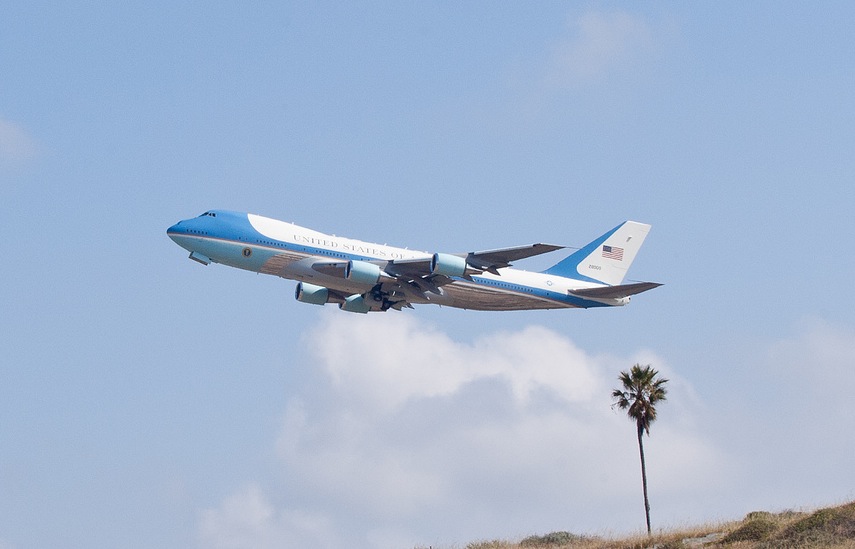
The typical five-hour flight from Washington, D.C. to Los Angeles costs anywhere from $300 to $500. This weekend, President Obama will be making that trip to deliver a commencement speech at UC Irvine—and attend a fundraising event in Laguna Beach ahead of the November midterm elections. He’ll be flying in a much fancier plane, of course, and there probably won’t be any crying baby or businessman snoring loudly in seat 37B. But another major difference? The president’s flight will cost you and me, and taxpayers all across America, about $228,000. Per hour.
The 10-hour round-trip total comes in at nearly $2.3 million, and that’s just the operating cost of Air Force One. It doesn’t account for the additional planes the President might require for his armored limousines, his Secret Service protection, their lodging and meals, or the support costs for his entourage of White House staffers coming along for the ride. There are also considerable expenses in terms of both time and money that the Southland cities he visits and passes through will incur by cordoning off streets and snarling traffic. In short, taxpayers will spend millions of dollars in order to allow the President to raise thousands of dollars.
Presidential travel has been an easy political target for decades, of course, especially by the side that’s out of office. And it’s easy to dismiss these expenses as insignificant in a $3.5 trillion federal budget. But we shouldn’t. What should particularly bother taxpayers, regardless of their political persuasions, is the fact that there is virtually no transparency surrounding a president’s use of this immensely powerful perk.
Political parties and campaign teams are required to reimburse the government whenever the president travels on their behalf. It’s taxpayers, however, who almost always end up footing most of the total bill, because under existing rules (or lack thereof), it’s left up to White House officials to determine which portions of any trip are official and which are expressly political. So when a President wants to attend a fundraising dinner with A-list actors in Hollywood, the expense can be offset by making a stop at a nearby business or school to speak about issues like immigration reform, healthcare, or student loan rates. Presto! Now the trip is for “official” business.
It’s been this way for years, and the rules are so vague that not even researchers who study them full-time can describe them. In a 2012 report, the Congressional Research Service stated that it’s “unclear how the White House designates travel that is not directly related to a governmental or political function.” Basically, the president gets the benefit of the doubt.
This makes it easy for schedulers to add a sprinkling of “official” business to any trip, and it opens the door for any party to game the system. Ultimately, this is to the detriment of every American’s bank account as well as an electoral process that’s becoming increasingly expensive and time-consuming.
To be sure, security concerns surrounding presidential travel require some secrets to be kept. And in today’s hyper-partisan political environment, where just about everything that anyone in Washington does inevitably draws criticism from across the aisle, examining what constitutes political or official travel could devolve into pointless fighting or political posturing. But just because a policy has been in place for years doesn’t mean that it’s a good one.
Fortunately, there’s been a little more attention paid recently to the issue of taxpayer-subsidized fundraising. In 2009, the Federal Election Commission updated its rules to require campaigns to reimburse the government at charter flight rates, which are significantly higher than commercial flight costs. That means that President Obama’s 2012 re-election campaign paid much more for Air Force One usage than, for example, President George W. Bush did in 2004, or President Bill Clinton in 1996. It’s a start at least.
Still, the rules need to be explicit, and the steps any administration takes in order to follow them need to be plainly visible and easily reviewed. This means more thorough and timely public access to travel records and costs as they are incurred (within carefully defined considerations for security). Regardless of whether it’s technically legal or “by the books,” and no matter who occupies the Oval Office, this type of activity should be less of a secret to the everyday Americans who must pay for it.
Let me be clear: the problem isn’t as simple as a $2.3 million flight to California. It isn’t that we have reason to believe the president has intentionally abused his travel privileges. It’s just that without a more transparent system, we’d never have any idea if he did.





Send A Letter To the Editors